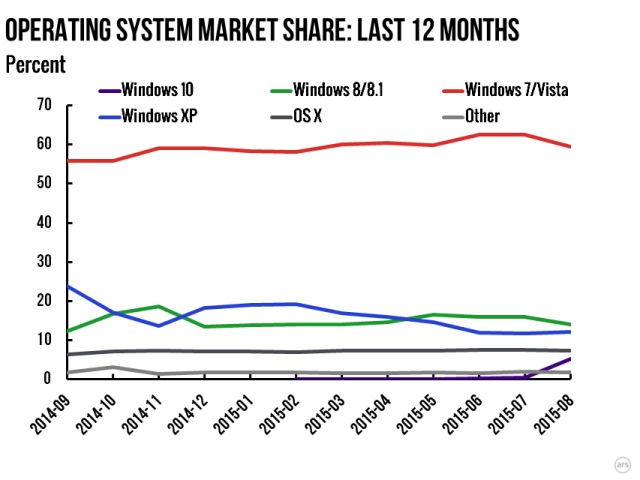
In its first full month on the market, Windows 10 appears to command about 5 percent of the PC market. That's not just fast: it's unprecedented. Windows 8 took about 6 months to achieve the same penetration. Even Windows 7, a much less divisive operating system than Windows 8 that was warmly welcomed and regarded as a welcome antidote to Windows Vista, took a couple of months to hit the same level of usage.
The absolute number is high, too: Microsoft announced 75 million installations last week. Windows 8's first month saw only 40 million licenses sold, again showing the relative popularity of the two operating systems.
Even the business numbers seem encouraging. Microsoft rarely breaks these out, so it's difficult to construct any true comparison, but the company told us that 1.5 million installations were of the Windows 10 Enterprise version. That's only available to Software Assurance licensees (and MSDN subscribers), and while it's still only a small proportion of the install base, it's significant. Corporate users tend to be more than a little conservative when it comes to rolling out major operating system upgrades. More than a few only completed their migrations away from Windows XP within the last year. 1.5 million users suggests that there's already meaningful corporate interest in the new operating system, which is something that Windows 8 could never really boast.
Of course, we should expect Windows 10's uptake to be different from that of its predecessors, because Windows 10's price is different from its predecessors. Virtually none of those 75 million Windows 10 users is likely to have paid a penny for the update. For Windows 7 and 8 Home and Pro users, the upgrade is free until the end of July next year. For corporate customers with active Software Assurance agreements, the latest version of the operating system is always available at no additional charge.
Never before has a major-version Windows release been pushed out to all and sundry over Windows Update. While this process has not been perfect, with the gloriously unhelpful "Something Happened" error a particular low point, it was nonetheless a brave move by Microsoft, testing the Windows upgrade process on a scale that it's never been tested before. Given that historically the popular advice has been to never upgrade Windows, but to perform a fresh install, the overall success of these upgrades is remarkable.
If nothing else, Windows 10 has taught us that Windows major version upgrades work. And if the Windows as a Service model proves successful, Windows major version upgrades will never be needed again. Microsoft's internal testing, including inviting employees to bring in their old, crappy hardware to test the upgrade process, seems to have paid dividends.
But there's still a huge mountain to climb. Microsoft didn't make the Windows 10 upgrade free just for fun. As the graph above shows, the Windows user base is actually quite fragmented. A majority of users are on Windows 7, with the rest split between Windows XP—still—Windows 8, and, now, Windows 10. With Microsoft wanting to stimulate as much development for the Windows Store as it can, this is a problem; far and away the best way to target Windows users is to ignore the store and build a conventional, old-fashioned Win32 application.
If the market share were reversed—if it were Windows 10 with about 60 percent of the desktop market, and the rest split between 7, 8, and yes, probably still some XP zombies that will never die—then that calculus may very well change, with the Store a much better target for the building and promoting of software. The free upgrade is designed to stimulate that switch, and in its first month, it appears that it's doing the right thing; Windows 7 and 8.1 both saw declines in usage that matched Windows 10's gains. Windows XP, which isn't eligible for the upgrade, didn't appear to shift at all. One might argue that it may have been worth extending the upgrade even to those users, but if the end of support didn't stimulate upgrades, it's hard to imagine that a whole new operating system would.
Microsoft's ambitions are certainly high; though the stated goal varies each time it's mentioned, broadly speaking the company wants to have 1 billion Windows 10 users within the first two years of availability, requiring about two-thirds of current Windows users to make the switch. That's not impossible, but it's not going to be easy. One billion users in two years is about 40 million a month. That means that Microsoft needs to sustain Windows 10 installations at the same rate as it achieved in Windows 8's launch month. The first few months normally represent something of a high point in operating system uptake; after half a year on the market, Windows 8 had dropped to an average of about 16 million installations a month. While we'd certainly expect the uptake of the new operating system to be faster than Windows 8's was, Microsoft appears to be counting on more than double the rate of installations—and keeping that rate month in, month out.
All in all, it's a good first month for Windows 10. But there's a long journey ahead. We're going to be keeping an occasional eye on the progress of the new operating system to watch the continued impact of the free upgrade and see how close Microsoft will get to its 1 billion installation goal.
reader comments
145